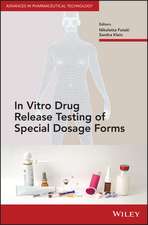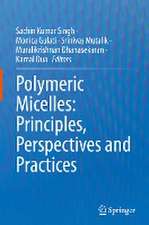Pharmacognosy: Fundamentals, Applications and Strategies
Autor Rupika Delgoda Editat de Simone Badal McCreathen Limba Engleză Paperback – 7 dec 2016
The book is vital for future research planning, helping readers understand the makeup, function, and metabolites of plants in a way where the history of their usage can be linked to current drug development research, including in vitro, in vivo, and clinical research data.
By focusing on basic principles, current research, and global trends, this book provides a critical resource for students and researchers in the areas of pharmacognosy, pharmacy, botany, medicine, biotechnology, biochemistry, and chemistry.
- Covers the differences between animal and plant cells to facilitate an easier transition to how the body interacts with these entities
- Contains practice questions at the end of every chapter to test learning and retention
- Provides a single source that covers fundamental topics and future strategies, with the goal of enabling further research that will contribute to the overall health and well-being of mankind
Preț: 741.75 lei
Preț vechi: 913.74 lei
-19% Nou
Puncte Express: 1113
Preț estimativ în valută:
141.95€ • 147.65$ • 117.19£
141.95€ • 147.65$ • 117.19£
Carte tipărită la comandă
Livrare economică 07-21 aprilie
Preluare comenzi: 021 569.72.76
Specificații
ISBN-13: 9780128021040
ISBN-10: 0128021047
Pagini: 738
Dimensiuni: 216 x 276 x 41 mm
Greutate: 1.68 kg
Editura: ELSEVIER SCIENCE
ISBN-10: 0128021047
Pagini: 738
Dimensiuni: 216 x 276 x 41 mm
Greutate: 1.68 kg
Editura: ELSEVIER SCIENCE
Public țintă
Students and researchers in the fields of pharmaceutical science, pharmacy and pharmacognosy; students and researchers in medicine, biotechnology, botany, biochemistry and chemistryCuprins
Part I: Pharmacognosy 1011. Background to Pharmacognosy2. Traditional Medicine3. Areas of Science Embraced by Pharmacognosy: Constituent Sciences of Pharmacognosy4. Plant Anatomy and Physiology5. Plant Constituents: Carbohydrates, Oils, Resins, Balsams, and Plant Hormones6. Plant Crude DrugsPart II: Plant Metabolites: Their Chemistry7. Evolutionary Perspectives on the Role of Plant Secondary Metabolites8. Glycosides9. Alkaloids10. Tannins11. Terpenoids12. Other Plant Metabolites13. VitaminsPart III: Plant Metabolites: Their Effects14. Chemotherapeutics15. Bioactive Plant Molecules, Sources and Mechanism of Action in the Treatment of Cardiovascular Disease16. Plant Metabolites and More Treating Various Ailments: Natural Products Treating Diseases17. Psychoactive DrugsPart IV: Metabolites from Other Sources18. Marine Metabolites: Oceans of Opportunity19. Animal Metabolites: From Amphibians, Reptiles, Aves/Birds, and Invertebrates20. Fungal MetabolitesPart V: Crude Drugs from Animals21. Fats22. Waxes
Part VI: Basic Animal Anatomy and Physiology23. Form and Function of the Animal Cell24. Proteins25. Pharmacokinetics26. Pharmacodynamics - A Pharmacognosy Perspective27. Drug MetabolismPart VII: Technological Applications Using Biological Systems28. BiotechnologyPart VIII: Current Trends in Pharmacognosy Research29. Natural Product Structure Elucidation by NMR Spectroscopy30. Metabolomics Approach in Pharmacognosy31. Novel Targets in Drug Discovery32. Nanotechnology: Building and Observing at the Nanometer Scale33. Ethical Aspects of Working With Local Communities and Their Biological Resources34. Factors to Consider in Development of Nutraceutical and Dietary Supplements35. The Global Regulatory Framework for Medicinal Plants36. The Potential Role of Bioscience Industries in Small Developing Economies
Part VI: Basic Animal Anatomy and Physiology23. Form and Function of the Animal Cell24. Proteins25. Pharmacokinetics26. Pharmacodynamics - A Pharmacognosy Perspective27. Drug MetabolismPart VII: Technological Applications Using Biological Systems28. BiotechnologyPart VIII: Current Trends in Pharmacognosy Research29. Natural Product Structure Elucidation by NMR Spectroscopy30. Metabolomics Approach in Pharmacognosy31. Novel Targets in Drug Discovery32. Nanotechnology: Building and Observing at the Nanometer Scale33. Ethical Aspects of Working With Local Communities and Their Biological Resources34. Factors to Consider in Development of Nutraceutical and Dietary Supplements35. The Global Regulatory Framework for Medicinal Plants36. The Potential Role of Bioscience Industries in Small Developing Economies


























